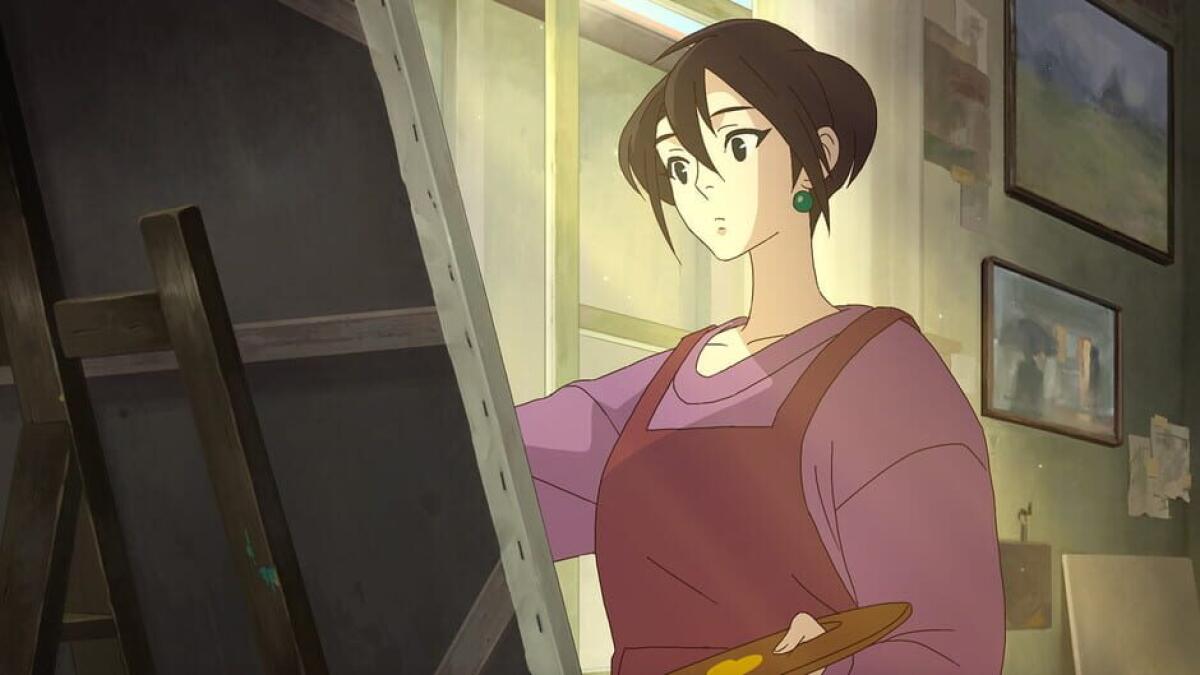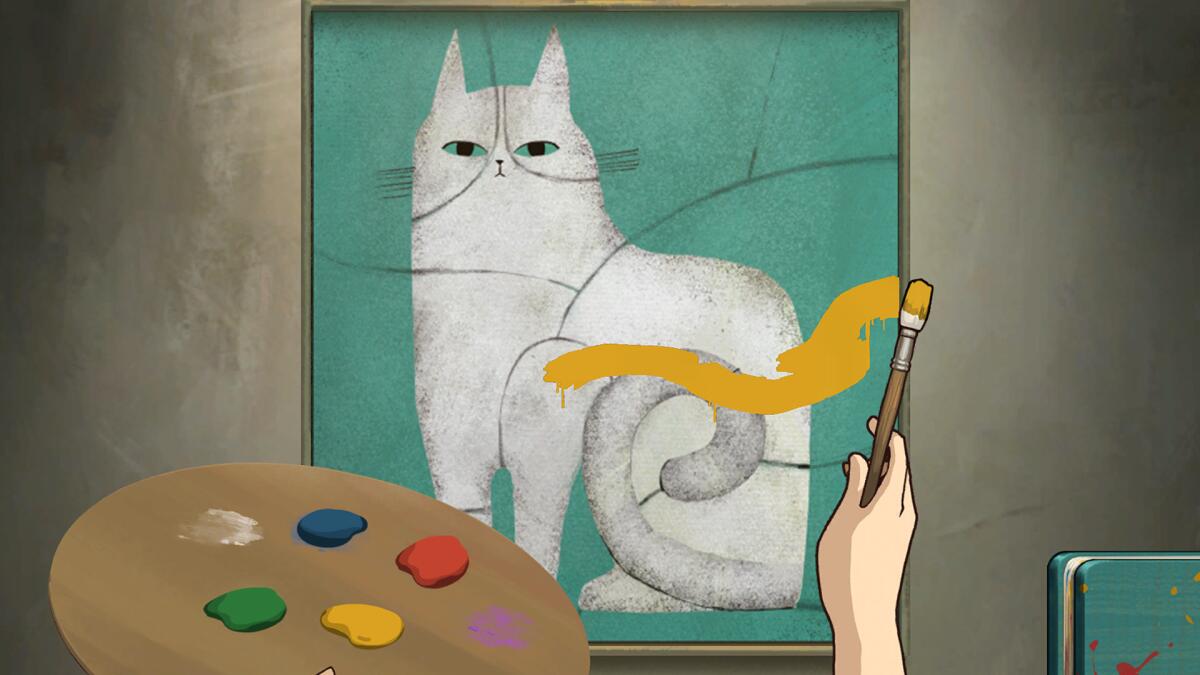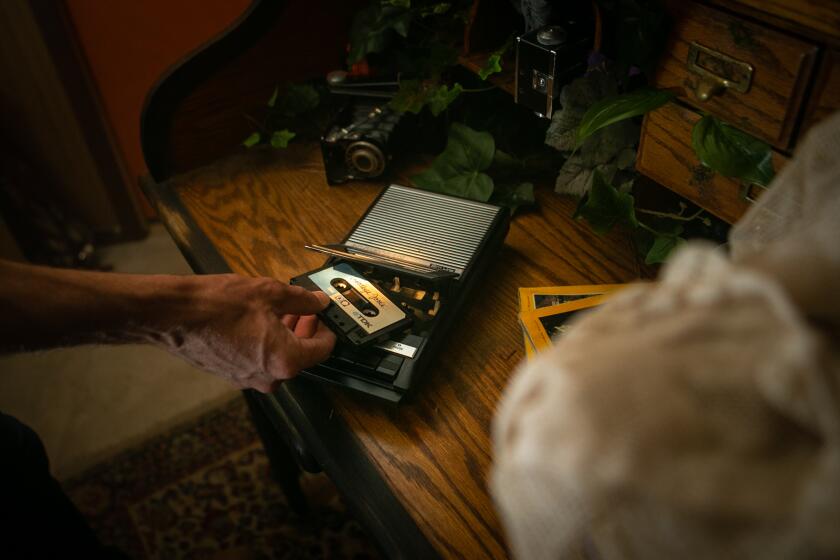‘Behind the Frame’ is a touching, interactive tale of art, cats, love and loss

- Share via
Memory is a malleable, fragile thing.
I’ve never thought more about memory’s fleeting nature than I have this past year and a half of pandemic life. An insecure fear that a loved one or former partner would forget about time we shared together has become front of mind, the result of so much uncertainty in our lives.
Surrounded at home by an accumulation of stuff, I’ve spent a lot of time contemplating whether what I’ve purchased over the years truly matters. Is there a memory attached to it, or was it something that simply caught my eye in a shop? What experience is secured to it, and if there isn’t one, do I truly need it? It’s safe to say that I’ll probably never purchase a Disneyland snow globe again.
More recently, I’ve acquired a crop of notebooks to carry around with me. I’m not much for journaling — I already write all day for work — and my drawing talents are a few rungs below rudimentary, but I’ve been using them for sketches. When a memory is drawn, it’s more likely to be saved eternally in our minds. The sight of my scribbles and scratches possesses the power of recalling a day, a time, smells, people.
“The Nest” is billed as immersive theater, but it’s really an exploration-focused video game. Think “Gone Home,” but sprung to life.
This isn’t a nostalgia play. It’s a pandemic realization of the need to keep moving forward while still looking back fondly and staying connected to those important to us — not for sentimentality purposes but for lessons in who we are, where we have been and who we have yet to become. It was a delight, then, to discover a game, “Behind the Frame: The Finest Scenery,” that seemed to have similar thoughts on its mind.
Think of “Behind the Frame” as an interactive animated film in which light puzzles jog the memory of the protagonist. The Taiwanese creators of the game at Silver Lining Studio have been vocal in their desire to capture the lilting, melancholic and pensive tone of late-era Studio Ghibli films in this hour-or-so-long game.
Moments of potentially high drama, such as when a cat goes missing, are resolved quickly — this isn’t a game with problems to solve or objects to hunt. Instead, “Behind the Frame” wants to focus on the delicacy of its characters’ relationships, the beauty in sharing a conversation and also how life’s obligations result in most connections being ephemeral in nature.

Throughout, there are hints at the passage of time. A white cat with orange streaks goes from spry to plump. A solitary neighbor sits at home all day, his life’s adventures captured only in his oil paintings that surround him. Cleverly, most of the game’s puzzles allow the users, too, to create something. For example, when a password is missing, we must find the directional cues that allow us to connect dots into numbers.
When we solve a puzzle, what we find is a tube of paint, each color associated with a different emotion or theme of the game. The paint’s use — or lack thereof — mirrors different feelings in the lives of these digital characters. There’s both joy and heartbreak, for instance, in merely securing a container of purple paint, one that had largely been locked away because it evoked the too-powerful memories of sitting in garden fields with a lover. Life, “Behind the Frame” seems to say, is full of color, but too often we see only what we want.
There are aspects of “Behind the Frame” that are left undefined. Our goal, such as it is, is to paint pictures. I recommend playing on a mobile phone, which allows you to use the touch screen as a canvas. Each painting we create or find throughout the apartment of the main character, Amber, signifies a moment in one of her most impactful relationships. Sometimes we have to dig into a notebook to re-create a scene Amber lived. Other times, Amber’s sketch just needs to be filled with color.
To find what a painting is lacking, “Behind the Frame” occasionally gives us a brief puzzle. These are largely memory-based, taking what we’ve seen in one image or part of the apartment and applying it to another.
The charming and therapeutic “Cozy Grove,” inspired by “Animal Crossing,” is just one recent release in the “wholesome games” movement. Why the games resonate.
As we uncover and bring to life the art in Amber’s apartment, we can contemplate along with her the life choices and sacrifices she made. I didn’t see “Behind the Frame” as a romance, although it is a story of love, both felt and unrequited. The greatest passion here is the art that’s created — the paintings of Amber and the oil paintings of her aging neighbor, whose relationship to her serves as a light mystery that pushes the narrative forward.
“Behind the Frame” could be read as a tale of loneliness, as the tragedy in Amber’s relationship does become apparent early on. But that’s revealed not to sadden us so much as to awaken us, to remind us that our memories must be cultivated and exercised as much as any craft or skill.
There’s also a lesson. Interpersonal risks are the easiest to avoid, especially in the face of a thriving, successful and stressful career, but a full life is a living work of art in itself. The act of remembrance is powerful, but it can also become a symbol of avoidance. “Beyond the Frame” walks that line, ultimately celebrating the joy of sketching, painting and creating.
'Behind the Frame'
More to Read
The biggest entertainment stories
Get our big stories about Hollywood, film, television, music, arts, culture and more right in your inbox as soon as they publish.
You may occasionally receive promotional content from the Los Angeles Times.












